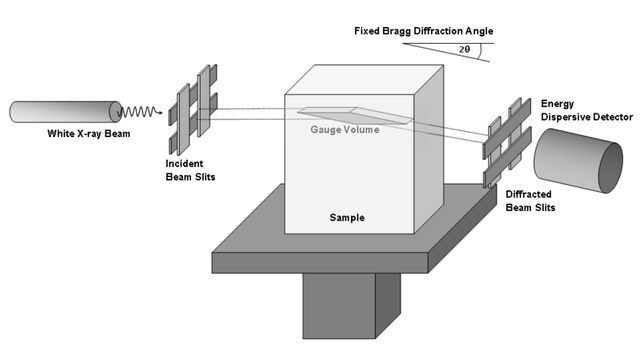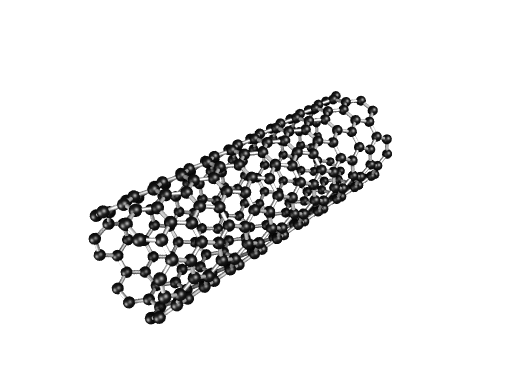X-ray diffraction (XRD) applied to carbon nanotubes.
X-ray diffraction (XRD) applied to carbon nanotubes.
Hello dear steemians of the scientific community #steemstem, in this opportunity I would like to explain to you one of the most used techniques in the characterization of carbon nanotubes, X-ray diffraction.
X-ray diffraction (XRD).
The X-ray diffraction technique (XRD) is a non-destructive technique used in the analysis of crystalline materials, which uses a range of wavelengths between 0.5-2.5nm.
The interaction of X-rays with a crystalline material generates a phase wave pattern that is usually interpreted by Bragg's law.

Source
This pattern of intensities will depend on the position of the diffracted beams which depends on the size and shape of the repetitive unit of the crystal (unit cell).
The characterization of graphite materials by X-ray diffraction is a technique widely used to measure the spacing between graphene layers, possible structural stresses and to determine impurities in the samples.
The main characteristics of the X-ray diffraction pattern in carbon nanotubes are:
A large peak at 2θ = 26 ° corresponding to graphite (002) with an interplanar spacing of 0.34 nm. The intensity and width of the peaks (0 0 2) are related to the number of layers due to variations in inter-layer spacing, lattice distortions and the orientation of carbon nanotubes compared to the X-ray beam.
Several small intensity peaks corresponding to plane (100) at 2θ = 42.4 ° and (110) 2θ = 77,7°.
X-ray diffractometer.
The main components are the x-ray tube with a copper anode, with a closed cooling system (water), grids, monochromator, and detector. The detector contains xenon; This type of gas is suitable for detecting Cu Ká wavelength radiation or long wavelength.

Source
The x-rays are generated in the tube, which is a vacuum ampule that houses the positive electrode (anode) and the negative one (cathode). The cathode contains a tungsten filament through which the electrons travel, produced by a potential difference of 45,000 volts, which collide with the copper target (can be Mo, Fe, Co, etc.). The electrons that hit the target produce the background x-rays that pass through a beryllium window that, due to its low atomic number, allows the passage of x-rays.
The information obtained from the diffractograms allows determining the crystalline system to which the compound belongs as well as the cell parameters, that is, the minimum unit with which a crystal is organized. With the intensities of the reflections, it is possible to determine the distribution of the atoms within the cell (structural analysis). The geometry of the profiles in the "peaks" or maximum diffraction, allows determining the size of the crystals.
X-ray diffraction of carbon nanomaterials.
One of the applications of the XRD in nanosciences is to determine the structures of new compounds from their diffraction patterns to later associate the structure of the compound with its properties.
Another routine application is to identify the composition of a sample based on its crystalline structure. This is common when you want to prepare a compound that is already known but using new methods, either because they are cheaper, higher performance or less toxic.
The identification is made from the profile (or pattern) of characteristic x-ray diffraction for each natural or synthetic compound, which is like a fingerprint.

Source
References.
- https://www.researchgate.net/publication/269286576_Carbon_Nanotubes_Characterization_by_X-ray_Powder_Diffraction_-_A_Review
- http://pubs.rsc.org/en/Content/ArticleLanding/2010/NJ/c0nj00395f#!divAbstract
- https://www.sciencedirect.com/science/article/pii/S0921510705001315
- https://www.researchgate.net/post/How_can_we_differentiate_graphene_and_graphite_using_X_ray_diffraction_pattern_and_Raman_Spectoscopy

Awesome great work explaining it very interesting stuff upvoted.
thanks, It's a really great technique
Your Post Has Been Featured on @Resteemable!
Feature any Steemit post using resteemit.com!
How It Works:
1. Take Any Steemit URL
2. Erase
https://3. Type
reGet Featured Instantly � Featured Posts are voted every 2.4hrs
Join the Curation Team Here | Vote Resteemable for Witness
Congratulations! This post has been upvoted from the communal account, @minnowsupport, by giovaabbatichio from the Minnow Support Project. It's a witness project run by aggroed, ausbitbank, teamsteem, theprophet0, someguy123, neoxian, followbtcnews, and netuoso. The goal is to help Steemit grow by supporting Minnows. Please find us at the Peace, Abundance, and Liberty Network (PALnet) Discord Channel. It's a completely public and open space to all members of the Steemit community who voluntarily choose to be there.
If you would like to delegate to the Minnow Support Project you can do so by clicking on the following links: 50SP, 100SP, 250SP, 500SP, 1000SP, 5000SP.
Be sure to leave at least 50SP undelegated on your account.